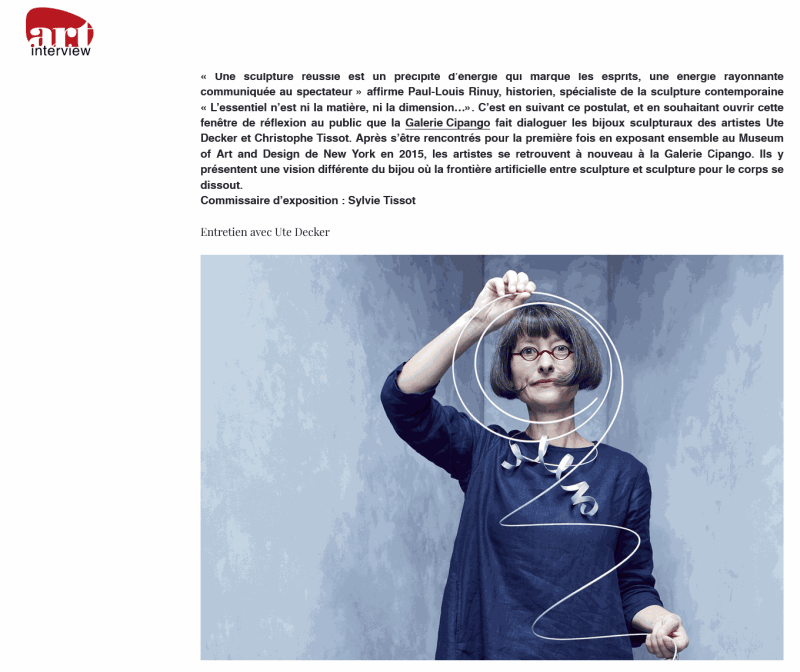“A successful sculpture is the expression of energy that makes a lasting impression, a radiant energy that is communicated to the viewer, says Paul-Louis Rinuy, historian and specialist in contemporary sculpture. “Neither materials nor size matter…”
It is with this premise in mind, that Galerie Cipango is creating a dialogue between the sculptural jewellery pieces of artists Ute Decker and Christophe Tissot. After meeting for the first time exhibiting together at the Museum of Art and Design in New York in 2015, the artists come together again at Galerie Cipango to present a different vision of jewellery where the artificial distinction between sculpture and sculpture for the body becomes fluid and blurred.
Exhibition curator: Sylvie Tissot
Your jewellery is a sculpture, coming to life in a singular three-dimensionality. Where do you draw your inspiration from? What is the philosophy behind your work?
Most pieces start as explorations in sculptural forms. I never truly know what the end result will be: there is always something unexpected and this surprise, I hope, is transferred to the wearer upon engaging with the piece physically.
My interest in emptiness as a sculptural medium is born from my engagement with the philosophy of Zen and the concept of ‘The Empty Mind’, in which we are free from the illusion of a separate self and can understand the interconnectedness of all things. When I draw emptiness into the work – a moment of repose in the piece – it becomes all the more powerful as we focus intently on the contrasting line of material, analogous to the rhythmic pauses of a musical composition. For me the desire – in the making and the wearing – is that we stop and we listen; we are drawn out of the unfurling activity of a chaotic world.
The concept of play is as equally important to my practice.
The Articulation neck piece, for example, is made up of segmented linear pieces of recycled silver – every time it is placed around the neck its metallic branches angulate in entirely unique ways, animated by the wearer’s body, movement and choices; crossed over itself multiple times or twisted in a surprising direction and it becomes a new piece again.
I experience it on my body, until intuition tells me I am ready to make the final jewellery piece.
Your jewellery is minimalist and bold, with clean, free lines. How do you approach working on the jewellery? Do you start faithfully from a sketch, or do you leave it to chance to manipulate the long ribbons of gold and silver?
I first explore forms using garden wire, which is then translated into a brass maquette. I wear this maquette for months – interacting and playing with it, understanding its personality, guiding it through tiny adjustments as I experience it on my body, until intuition tells me I am ready to make the final jewellery piece.
Next, I work for many uninterrupted hours in the studio; based on the intimate knowledge of the maquette’s shape, I gather a soft, dynamic flow of energy into making – akin to the practice of calligraphy. It becomes an intuitive almost meditative act.
Each piece is hand-sculpted this way, thus even within a series, each becomes a unique miniature wearable sculpture with its individual character.
You are one of the leading voices in the international ethical jewellery movement. Could you tell us more about this approach?
As artists we transform material into stories and meaning; into objects that make you think and feel. Yet, we often forget materials have their own stories, their own historical, environmental and social realities. The carefully chosen provenance of my materials is the origin of each piece’s deeper beauty.
As a political economist-turned-journalist-turned-jeweller, I was one of the first in the world to work with fully traceable, certified, Fairtrade gold. That was in 2011. While it’s heartening now to see ethics in jewellery is becoming accepted practice among an ever wider group of makers, who take on this complex and thorny issue with the research and commitment it deserves.
Sadly, “green-wash” has become widespread. Thus You can find a wealth of practical information on ethical jewellery choices for both consumers and jewellers on my website. We have agency within this narrative – to play, to innovate, to commune, to seek a moment of repose, so that we may reflect on the interconnectivity of a universe much greater than ourselves.
As artists we transform material into stories and meaning; into objects that make you think and feel.
Vous pouvez lire l’article complet en français ici : https://artinterview.com/critique/ute-decker-et-christophe-tissot/
You can read the full article in English here: https://artinterview.com/en/critique/ute-decker-et-christophe-tissot/

